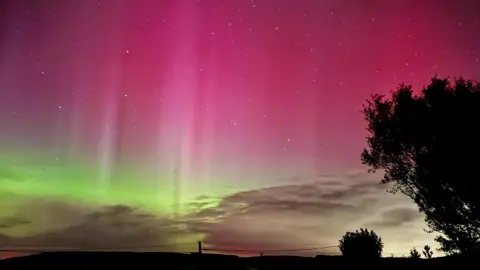Another year of extreme and varied weather for NI
 PA Media
PA MediaIt has been a year of extreme and varied weather for Northern Ireland.
From record-breaking storms and cold snaps to sunshine-filled days, we have seen it all.
The year started with a bang with three named storms all arriving in January.
Northern Ireland escaped the worst of Storm Henk at the start of the month but Storm Isha struck hard a few weeks later.
Winter: A stormy start
 Pacemaker
PacemakerAmber warnings were issued for Storm Isha, in which a man in his 60s died when his van was involved in a crash with a fallen tree.
Just a few days later, Storm Jocelyn brought major disruption to the road network.
Yet it was also a drier-than-average month overall, with just 86mm (3.4in) of rainfall - or 75% of the long-term average.
Despite the storms, Northern Ireland enjoyed above-average sunshine with 55.6 hours recorded, marking a bright start to the year.
Spring: Wet, stormy and record-breaking warmth
 Pacemaker
PacemakerSpring was a season of extremes with March and April both soaked by heavy rainfall
March recorded 149% average rainfall (129.2mm of rain), while April wasn't far behind on 141%.
Storm Kathleen in April also brought unseasonably strong winds and rain which caused disruption to travel and power supplies across Northern Ireland.
But spring ended on a high note with May becoming the warmest on record with a mean temperature of 12.9C - that's 2.4C above normal, despite being a dull month with just 75% average sunshine.
Summer was dull and dry, until August

Contrasting weather continued through summer with June and July being cooler, drier, and duller than average.
June saw just 75% normal sunshine and 74% of the average rainfall.
July remained below average for both - 78% and 86% respectively.
However, August bucked the summer month's trend and was very wet with almost 130% normal rainfall with temperatures and sunshine closer to average.
Autumn: New storm season

Calm conditions returned to mark the start of autumn with a sunny September (20% more sunshine that normal) and drier that normal conditions.
However the quieter weather was short-lived.
October saw Storm Ashley bring winds up to 81mph (130km/h) to County Down, causing disruption to travel and the electricity network.
Storm Bert in November triggered power outages, travel delays and severe flooding.
Derrylin in Fermanagh recorded 65.2mm of rain in just a few days - more than half a month's typical rainfall.
Northern Ireland missed the worst of Storm Conall at the end of November, but Storm Darragh brought havoc at the start of December with an amber warning issued across the country.
A red wind warning - the highest level - was in place in some counties in the Republic of Ireland for the storm.
Warmest Christmas Eve on record
 PA Media
PA MediaNorthern Ireland again missed out on a white Christmas in 2024, but the weather still made history.
It was the mildest start to Christmas Day on record.
Allow X content?
A year of changeable weather
From the cold of January to the storms of autumn, Northern Ireland's weather in 2024 highlighted the region's temperate climate.
As the year closes, Northern Ireland looks ahead to what 2025 may bring.
